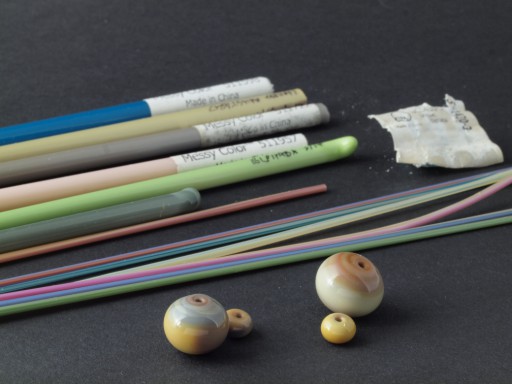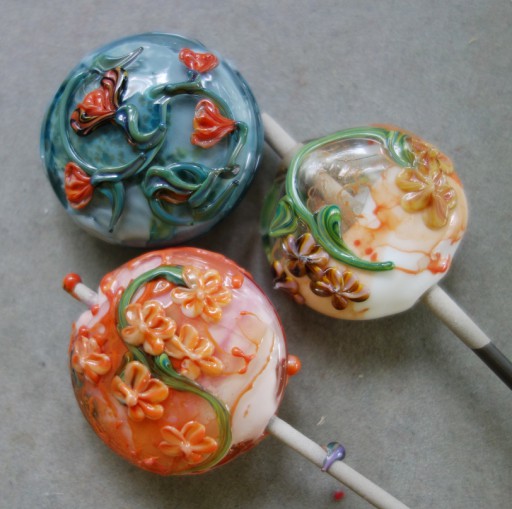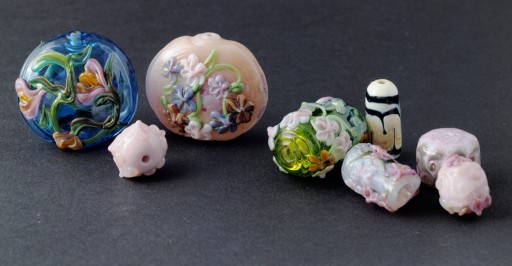I have been generating all sorts of opportunities to make hideous beads. First up, of course, are my continuing adventures with CiM. The April colors are
- Honey Mustard
- Cirrus (not pictured, sorry)
- Desert Pink
- Commando
And for May we have:
- Canyon de Chelly
- Atlantis
The elphaba special, along with daffodil (not pictured) are the March colors, and I've been trying to use them as well. Cirrus, Desert Pink, and particularly Atlantis all fall into the translucent/greasy category; Honey Mustard and Canyon de Chelly are striking silver bearing colors; Commando is a crawling (i.e. similar to petroleum) green. Elphaba is similar to pea green, and daffodil is a fairly standard cadmium opaque yellow.

I've been trying to take advantage of CiM's unique palette by making floral canes. The samples in the foreground are Canyon de Chelly[1] and Honey Mustard, respectively, with a hollow and solid spacer for each.
So here we have a semi-successful transparent hollow lentil, a little pink spacer decorated with a very subtle cane—cirrus cased with desert pink: those are the ‘beauties’. And then there are the fuglies. Oh my yes.
One of the things that CiM does well is translucents—so-called greasy glass. In Effetre, this would be your opalino and alabastro colors. The selection was pretty limited, and they weren't terribly popular; in addition to boiling and popping, they also were only marginally compatible. CiM, it must be said, has a lot of these, and they're much better behaved.
However, there are limits. The 1.5" lentil pressed pink floral, which was fine when it came out of the kiln a few days ago, has now cracked, and the crack follows the kugler raspberry frit—which along with seafoam green thompson enamel and tuquoise frit, make up the base color scheme. That's a bit much to ask of any opalino/alabastro type glass. The floral made on cirrus cracked completely. This, along with the crack in the leftmost bead in the bottom picture, are primarily a function of operator error—that is, I let the bead get too cold. And cirrus in particular is prone to cracking if not kept properly warm.

Three more-or-less pressed lentil beads. Top left: a greyish alt-lot of periwinkle, cased in palest aqua, with, um, silver blue frit; bottom left, white rolled in an TE orange pink, cased in trans 068 pink, decorated with shards made of a mix of coral and, er, ginger? and then floral trailed[2] ; right, clear and white base with more of the coral/ginger chards, trailed with canes made for the challenge.
I have been practicing lots of 5 petal daisy with my assorted canes.
But wait, what about that forlorn ivory and black bead in the middle photo? Um, that was the one I made on the mandrel spinner. This is kind of a pricey tool to purchase on spec, and I wouldn't’ve risked it without the wizard, whom I thought I could beg to modify the tool. Right now, it spins too fast, and it's too awkward to change the rotational direction—I'm hoping the wizard can set me up with foot controls for these parameters, which I think will make the tool a lot easier to use. But I strongly suspect, regardless of whether he manages these alterations, it will take some serious practice to get comfortable with it.
So what have I learned, besides the need to practice?
- Cirrus must be kept warm while trailing
- Desert Pink strikes! (2nd bead from the left)
- Canyon de Chelly and Desert Pink don't like each other (twist dot cylinder, 2nd from r)
- Desert Pink, kugler 96 frit and 9000 thompson enamels are incompatible (large pink lentil)
- EDP (eff254) cased in atlantis, with a stripe of clear? and Canyon de chelly makes for a nice blue-violet cane (mebbe skip the canyon next time)
- Daffodil and EDP and/or Canyon don't like each other, at least not with trans amber thrown into the mix... (dark flower petals with black in the pink lentil bead)
All in all, some promising areas to explore, but lots of bush to hack through before any gardens of pretty florals appear.
Beads made week of 30apr; photographed 30apr14.
Unless otherwise noted, text, image and objects depicted therein copyright 1996--present sylvus tarn.
Sylvus Tarn